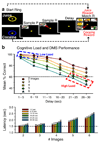Effects of cocaine rewards on neural representations of cognitive demand in nonhuman primates
- PMID: 20865250
- PMCID: PMC3126099
- DOI: 10.1007/s00213-010-2017-2
Effects of cocaine rewards on neural representations of cognitive demand in nonhuman primates
Abstract
Rationale: Investigations of the neural consequences of the effects of cocaine on cognition have centered on specific brain circuits including prefrontal cortex, medial temporal lobe and striatum and their roles in controlling drug dependent behavior and addiction. These regions are critical to many aspects of drug abuse; however recent investigations in addicted individuals have reported possible cognitive deficits that impact recovery and other therapeutic interventions.
Objectives: Therefore a direct assessment of the effects of cocaine as a reward for cognitive function provides a means of determining how brain systems involved such as prefrontal cortex are affected under normal vs. conditions of acute drug exposure as a precursor to the final impaired function in the addicted state.
Methods: Nonhuman primates (NHPs) were tested in a delayed-match-to-sample decision making task to determine effects of high vs. low cognitive load trials on single neuron activity and fluorodeoxyglucose-positron emission tomography (FDG-PET) determined metabolic activation of prefrontal cortex when juice vs. intravenous cocaine were employed as rewards for successful performance.
Results: Cognitive processing in prefrontal cortex was altered primarily on high load trials in which cocaine was randomly presented as the signaled and delivered reward on particular trials. The detrimental actions of cocaine rewards were also shown to persist and impair task performance on subsequent juice rewarded trials.
Conclusions: The findings indicate that one of the ways in which cocaine use may disrupt performance of a cognitive task is to alter neural processing in prefrontal cortex when involved in discriminating circumstances on the basis of low vs. high cognitive demand.
Figures







Similar articles
-
Acute cocaine induced deficits in cognitive performance in rhesus macaque monkeys treated with baclofen.Psychopharmacology (Berl). 2013 Jan;225(1):105-14. doi: 10.1007/s00213-012-2798-6. Epub 2012 Jul 27. Psychopharmacology (Berl). 2013. PMID: 22836369 Free PMC article.
-
The encoding of cocaine vs. natural rewards in the striatum of nonhuman primates: categories with different activations.Neuroscience. 2009 Sep 29;163(1):40-54. doi: 10.1016/j.neuroscience.2009.06.002. Epub 2009 Jun 6. Neuroscience. 2009. PMID: 19501630 Free PMC article.
-
The Abused Inhalant Toluene Impairs Medial Prefrontal Cortex Activity and Risk/Reward Decision-Making during a Probabilistic Discounting Task.J Neurosci. 2019 Nov 13;39(46):9207-9220. doi: 10.1523/JNEUROSCI.1674-19.2019. Epub 2019 Sep 23. J Neurosci. 2019. PMID: 31548237 Free PMC article.
-
Cognitive and motivational operations in primate prefrontal neurons.Rev Neurosci. 1998;9(4):225-41. doi: 10.1515/revneuro.1998.9.4.225. Rev Neurosci. 1998. PMID: 9886139 Review.
-
Review. Parallel studies of cocaine-related neural and cognitive impairment in humans and monkeys.Philos Trans R Soc Lond B Biol Sci. 2008 Oct 12;363(1507):3257-66. doi: 10.1098/rstb.2008.0102. Philos Trans R Soc Lond B Biol Sci. 2008. PMID: 18640916 Free PMC article. Review.
Cited by
-
Facilitation and restoration of cognitive function in primate prefrontal cortex by a neuroprosthesis that utilizes minicolumn-specific neural firing.J Neural Eng. 2012 Oct;9(5):056012. doi: 10.1088/1741-2560/9/5/056012. Epub 2012 Sep 13. J Neural Eng. 2012. PMID: 22976769 Free PMC article.
-
Prefrontal cortical minicolumn: from executive control to disrupted cognitive processing.Brain. 2014 Jul;137(Pt 7):1863-75. doi: 10.1093/brain/awt359. Epub 2014 Feb 14. Brain. 2014. PMID: 24531625 Free PMC article. Review.
-
Leveraging calcium imaging to illuminate circuit dysfunction in addiction.Alcohol. 2019 Feb;74:47-63. doi: 10.1016/j.alcohol.2018.05.013. Epub 2018 Jun 6. Alcohol. 2019. PMID: 30470589 Free PMC article. Review.
-
Nonhuman primate models of addiction and PET imaging: dopamine system dysregulation.Curr Top Behav Neurosci. 2012;11:25-44. doi: 10.1007/7854_2011_168. Curr Top Behav Neurosci. 2012. PMID: 22020537 Free PMC article.
-
Disruption of columnar and laminar cognitive processing in primate prefrontal cortex following cocaine exposure.Front Syst Neurosci. 2015 May 29;9:79. doi: 10.3389/fnsys.2015.00079. eCollection 2015. Front Syst Neurosci. 2015. PMID: 26074787 Free PMC article.
References
-
- Adinoff B, Devous MD, Sr, Cooper DB, Best SE, Chandler P, Harris T, Cervin CA, Cullum CM. Resting regional cerebral blood flow and gambling task performance in cocaine-dependent subjects and healthy comparison subjects. Am J Psychiatry. 2003;160:1892–1894. - PubMed
-
- Ashby FG, Spiering BJ. The neurobiology of category learning. Behav Cogn Neurosci Rev. 2004;3:101–113. - PubMed
-
- Bechara A, Martin EM. Impaired decision making related to working memory deficits in individuals with substance addictions. Neuropsychology. 2004;18:152–162. - PubMed
-
- Bechara A, Dolan S, Denburg N, Hindes A, Anderson SW, Nathan PE. Decision-making deficits, linked to a dysfunctional ventromedial prefrontal cortex, revealed in alcohol and stimulant abusers. Neuropsychologia. 2001;39:376–389. - PubMed
-
- Berns GS. Functional neural imaging. Life Sci. 1999;65:2531–2540. - PubMed
Publication types
MeSH terms
Substances
Grants and funding
LinkOut - more resources
Full Text Sources

